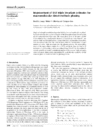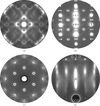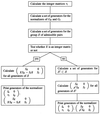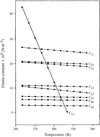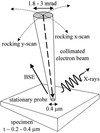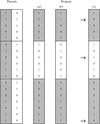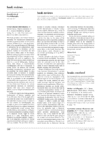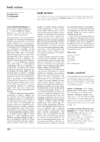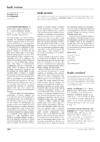issue contents
May 2001 issue

Cover illustration: Graphical representation of density modification due to third-order terms b113 = -b223 (point group ![]() ) in the Gram-Charlier series expansion of a Gaussian atomic probability density function. Courtesy of W. F. Kuhs.
) in the Gram-Charlier series expansion of a Gaussian atomic probability density function. Courtesy of W. F. Kuhs.
research papers
The new space-group-distinction method using the coherent convergent-beam electron diffraction (CBED) method is extensively applied to another ten space-group sets having principal rotation and screw axes, which are combined with other 2-fold-rotation axes.
The triplet distribution used for kinematical diffraction is extended to the complex case appropriate for dynamical transmission electron diffraction. It is demonstrated that this gives good results if the distributions are handled statistically rather than relying upon single triplet relationships.
The initial ab initio single-wavelength anomalous dispersion (SAS) triples invariant estimates from Hauptman's formula may be improved through quadrupole analysis.
It is shown that a feature that has been observed in the diffuse scattering patterns of a wide variety of different materials – a diffuse `ring' or `doughnut'-shaped region of scattering – can be understood in terms of a simple model that has been borrowed from the field of sol–gel science. In this it is supposed that there is a balance between the local attractive forces that are trying to make a particular structure and a rather longer range repulsive force that results from the strain that builds up in the lattice.
A finite algorithm for calculating a finite set of generators for the normalizer of a finite subgroup  of
of  in
in  is presented.
is presented.
Interatomic potential parameters obtained via empirical fitting for potassium tetrachlorozincate were found to reliably model the known crystallographic structures for the ferroelectric and paraelectric phases of the compound.
Structure factors based on periodic density-functional calculations on 25 molecular crystals have been used to evaluate trends in refined values of the κ and κ′ expansion–contraction parameters of the Hansen–Coppens multipole formalism. Average values for oxygen and carbon in different bonding environments are tabulated. Values for nitrogen appear more dependent on the details of the bonding to this atom.
A comprehensive theoretical description is presented along with numerical examples and discussion of a possible scheme of experiment for a new approach to the solution of the phase problem within a limited range of reciprocal-lattice vectors. The proposed approach can effectively supplement other phase-sensitive methods of crystal structure studies.
In the case of corundum (α-Al2O3), successes and pitfalls of multipolar models are described by comparison of charge-density results obtained from refinement against eight experimental and theoretical sets of moduli of structure factors.
A review of the symmetry groups of the various single-wall nano- and microtubes considered in the literature (BN, GaN, MS2, C, BC3, BC2N) is presented.
Sub- and supergroups of space groups are important tools for the prediction and investigation of continuous phase transitions. A new method is presented which facilitates the search for sub- and particularly supergroups of space groups. A new kind of phase transition is discussed.
Contrast in X-ray emission patterns as a function of crystal orientation is used to identify a sublattice site in Mg12X (X = La, Ce) occupied by 1 at.% Zn. Correlation with theory is necessary since no other atomic species occupies this sublattice site exclusively.
Net planes linking periodic and quasiperiodic directions in decagonal Al–Co–Ni have been studied. They may play a crucial role in growth and stabilization of decagonal quasicrystals.
The phase-determination capabilities of convolutional structure-factor equations are investigated on complex-valued electron densities. The new equations provide quite accurate extrapolated phases for real macromolecular problems and reveal underlying problems associated with the use of convolutional structure-factor equations in refinement in general.
The efficiency and inherent parallelism of evolutionary computational search methods make them potentially powerful tools for overcoming the phase problem in X-ray crystallography. The ability of such algorithms to extract structural information from scalar diffraction amplitudes is demonstrated by the ab initio computation of the molecular envelopes of two proteins from their corresponding diffraction data.
The polarization suppression of the interfering components in X-ray multiple-wave interaction is observed for the first time by using a polarization analyzer with an arbitrary inclination of the diffraction plane with respect to that of the investigated crystal. The proposed experimental polarization-resolved technique provides an operational way to enhance the visibility of X-ray multiple-wave interaction outside the investigated crystals for direct phase determination.
book reviews
Free 

books received
Free 

Free 



 journal menu
journal menu











